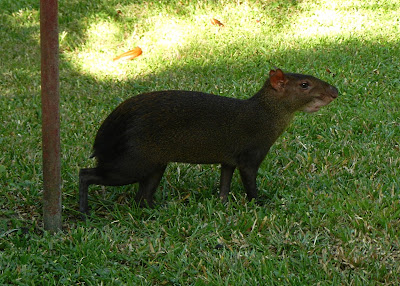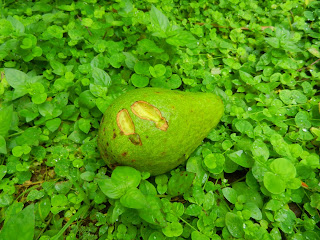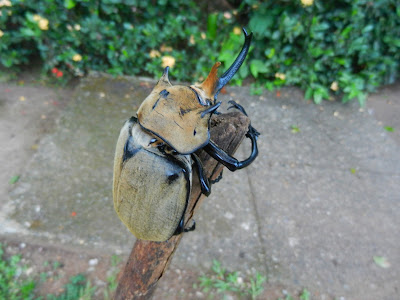Its the start of the rainy season here in Gamboa. Throughout the year, there is usually a chorus of frogs and other nocturnal animals every night. When it rains during the day, most days during the wet season, the frog chorus can be at times, deafening. Dozens of species sing from the flooded fields across from my house, in nearby residential pools of water, and from the extensive rain forest 300 metres in front of my house. The rainy season feels even more full of life than the drier times of the year. After a good rain, its always fun and rewarding to look for frogs after dark, and this is exactly what we did a few nights ago.
 |
| Tree Frog (species unknown) |
 |
| Tree Frog showing wide toe webbing |
It was still fairly dry, despite a bit of rain, as the wet season needs time to saturate the soils after the dry season. We decided to go up to the tower in Gamboa, as it is a good place to find snakes, frogs and other night life. We didn't see a great abundance of frogs, but each frog we saw seemed to be a different species from the last. Several different species of tree frogs including Dendrosophus ebraccatus, a small Hypsiboas species with large feet and toe webbing, Scinax sp., Leptodactylus savagei and more.
 |
| Panama Red-rumped Tarantula |
As we made our way up to the tower, we coaxed a rather aggressive Panama Red-rumped Tarantula, Sericopelma rubronitens, out of its burrow. We got a quick glimpse of it as it waited at the entrance of its burrow, but as we approached it scurried inside and out of view. By wiggling a stick at the entrance of its burrow, he came running out and attacked the twig, and was reluctant to let it go!
 |
| Turnip-tailed Gecko with no tail |
 |
| Turnip-tailed Gecko |
As we made our way up the tower, we spotted a Turnip-tailed Gecko (Thecadactylus rapicauda) along a railing. This large gecko is brown or tan in colour, and has the ability to change colour depending on its environment. They have rather complex toe pads, equipped with microscopic ridges and filaments to be able to scale just about any surface. It has a large, wide tail, giving it its name, which stores fat. On occasion, it can drop its tail to distract predators. Of the two Turnip-tailed Geckos we saw on the tower this evening, one was missing its tail!
Our highlight of the night was seen when we reached the top of the tower. As we approached the top, we saw some motion in the canopy. I mentioned the possibility of night monkeys, but there are plenty of other nocturnal mammals like Kinkajous and possums in these lowland forests. We could not see what was making the motion, so we carried on. As we got to the top, Beatriz took another look and immediately called out "monkeys!!". Sure enough, a family of 5 Panamanian Night Monkeys (Aotus zonalis) moved through the open branches of the canopy, right in front of us, not even 3 meters from the edge of the tower. One of them was carrying a baby on its back. Unfortunately, no photos! I knew my flash wouldn't make it, so I just enjoyed the sighting. Panamanian Night Monkeys are a small to medium-sized monkey in the family Aotidae. They are a brown to reddish colour, rather stout legs and a short prehensile tail. They have a rather round face with white vertical lines, and large round eyes, no doubt with excellent night vision. As we watched them move through the treetops, we couldn't help but enjoy this rare sighting. They are likely not uncommon, but due to their nocturnal and arboreal nature, are not frequently seen.
Thrilled with our finds at the tower, we made our way back home. Along the way, I spotted some eyeshine up high up in a tree, which upon further investigation with a flashlight, we saw the outline of a mammal-shaped animal, likely a woolly opossum, staring back at us with large eyes. Despite a lack of abundance of animals, what we did see was a good diversity and rewarding sightings. Night walks are a very enjoyable experience, and open our eyes to a world of creatures active after the daylight fades. Now that its the wet season, I look forward to doing some more evening exploring in Gamboa, who knows what will turn up!
~ Jenn








